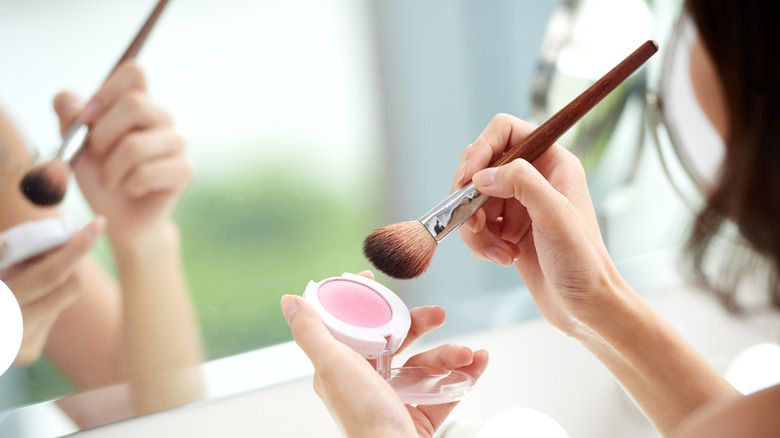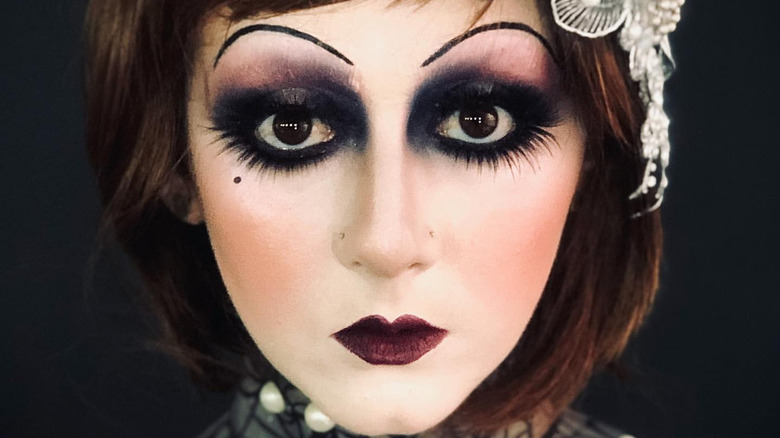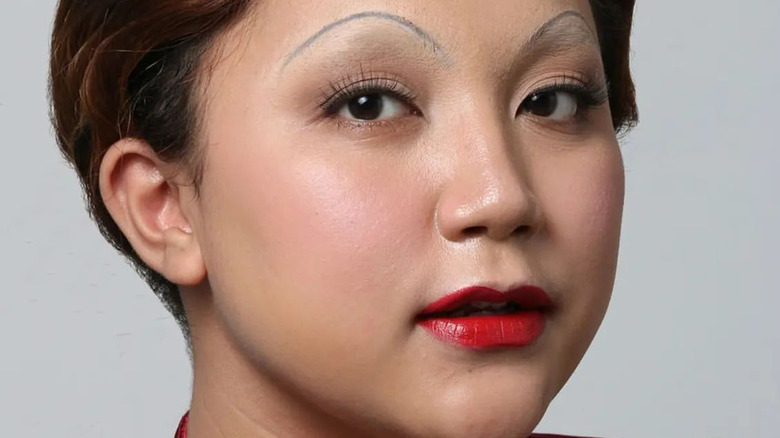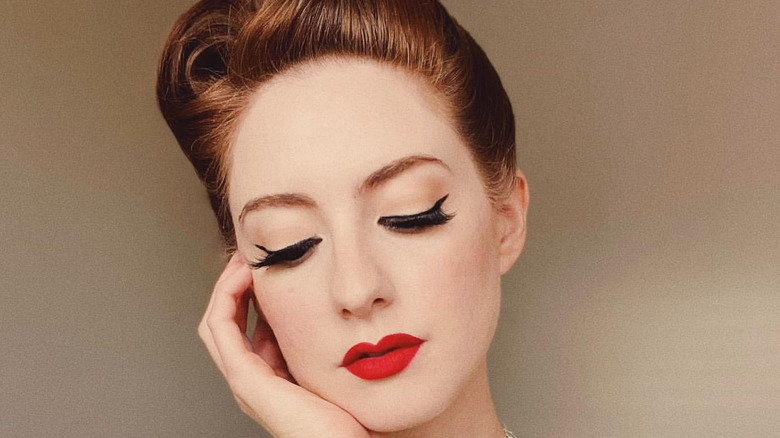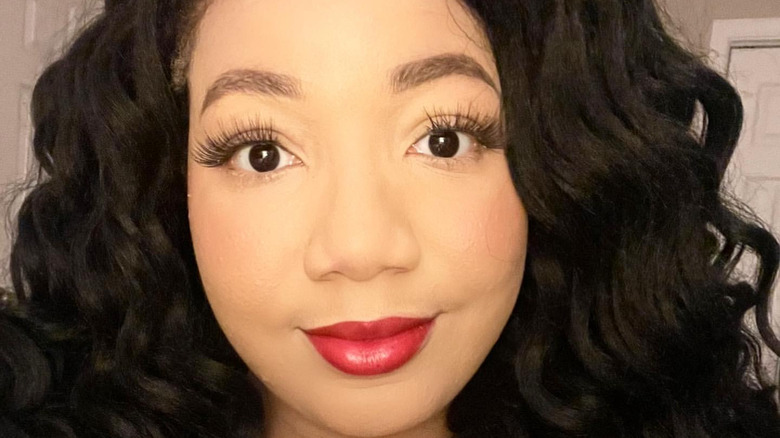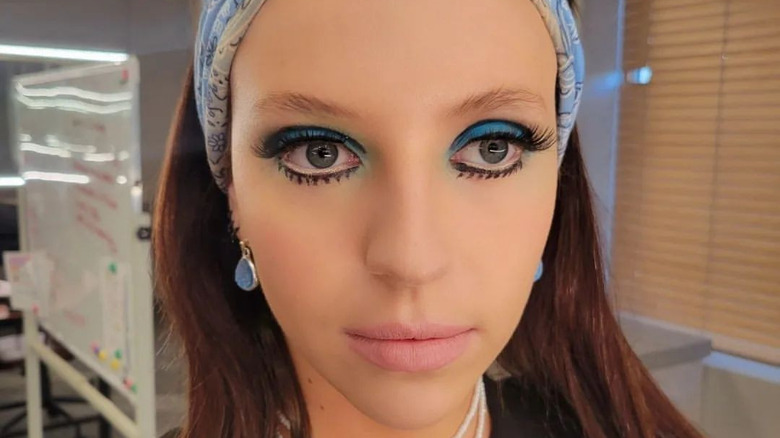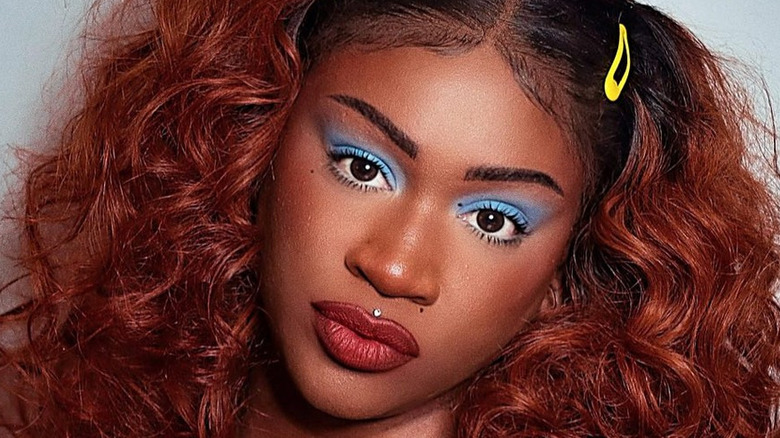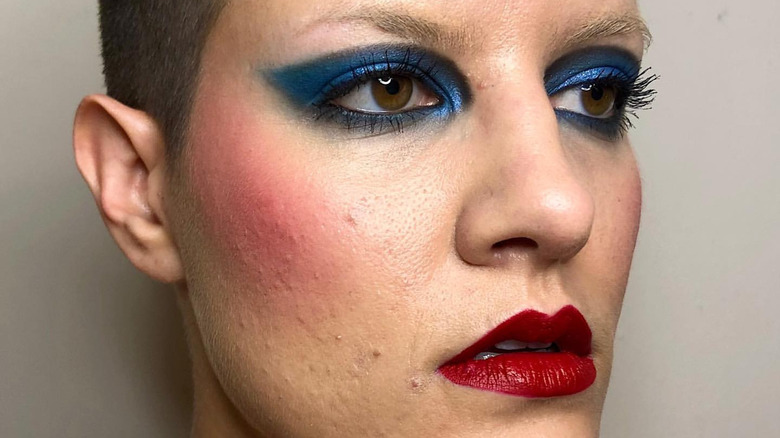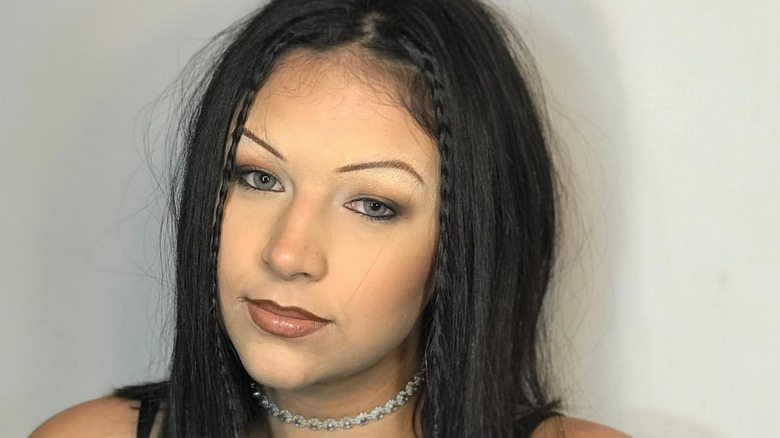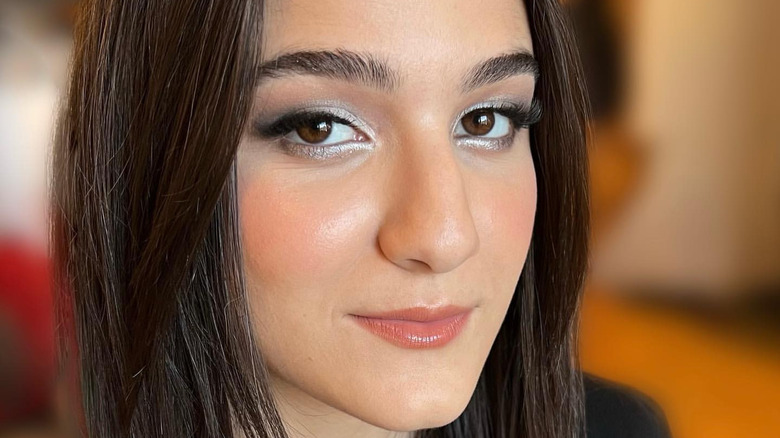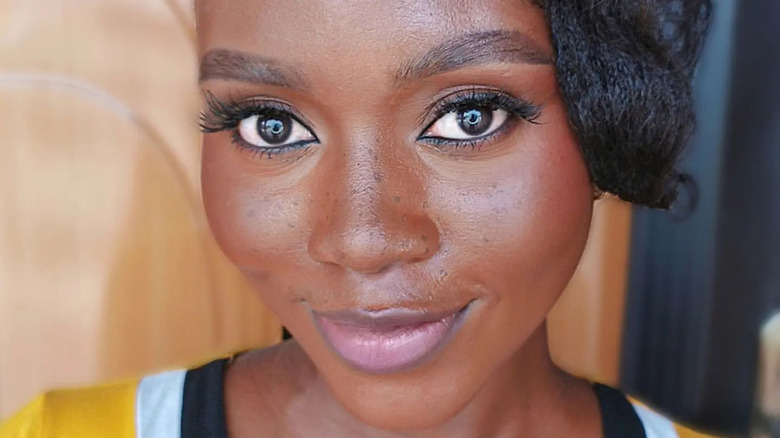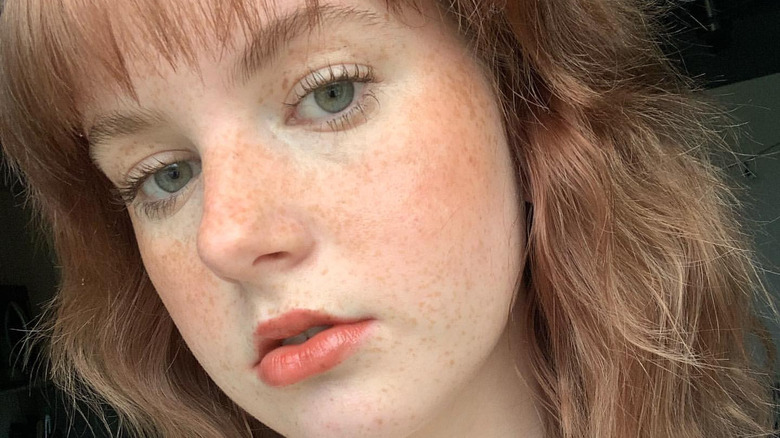100 Years Of Blush
Blush, blusher, rouge — whatever you call it, its use as a cosmetic to bring color to one's cheeks dates back thousands of years. In ancient Egypt, people used ground red ochre mixed with animal fat to bring a flush to their faces. In ancient Rome, the blush of choice was red vermilion, while ancient Greeks turned to crushed mulberries to get that status-y glow.
Flushed cheeks are associated with youth, perhaps because women's facial skin turns redder when oestradiol, a hormone that encourages fertility, is at its highest level. A 2009 study where volunteers digitally altered photos of faces to look more attractive found that, across the board, people reddened the skin in the photographs regardless of the subject's skin tone. The study's authors concluded, "It is likely, therefore, that the enhanced health appearance associated with increased skin blood color...has consequences for attractiveness and mate choice."
When Queen Elizabeth I of England ascended to the throne, she brought back a heavily rouged look that had been out of fashion during the Middle Ages. She favored a red, round blush placement, and society followed her lead, often with deadly results — cosmetic ingredients well into the 1900s could be extremely toxic (including lead and mercury). When the 1920s rolled around, blush was back again in the most dramatic of ways and has been a staple ever since, although you'll see its look has varied from decade to decade.
1920-1929: Red cheeks, red knees
In the 1920s, women's fashion and makeup became much more dramatic and colorful than they had been in the immediate past. The 1910s had seen new innovations in mass-produced cosmetics from brands like Max Factor and Revlon, and by the 1920s, there was a slew of options available to consumers. Pale skin was considered very chic, and blush, or rouge as it was known at the time, was applied heavily in circles on the cheeks to emphasize and contrast with a doll-like pallor.
The popular flapper look was all the rage and delighted in a frankly artificial appearance. Rouge was available in creams and papers that transferred color onto the skin. Another trend involving rouge was applying it to one's knees to draw attention to the skin exposed by shorter hemlines, which came into vogue during this time period. The 1975 musical "Chicago" paid tribute to this look in the song "All That Jazz" when the singer announces she's going to "rouge her knees and roll her stockings down" in preparation for a night of fun.
1930-1939: A subtle, healthy glow
After the more-is-more look of the 1920s, rouge trends swung in the opposite direction in the 1930s when women tended to use blush to impart a more subtle flush or glow to the skin that imitated the way in which skin naturally reddens during, say, a brisk walk or a conversation with a crush. The "fresh-faced" look tended toward subtle pinks that imparted a natural look with very light contouring rather than the stronger reds of the past. Rouge was available in liquid, cream, and powder forms; women often carried their cosmetics in beautiful compacts that celebrated and highlighted the use of cosmetics.
Furthermore, more shades became available, giving women more options when putting together makeup looks. And while the 1920s may have cornered the strange blush trend market with rouged knees, the 1930s had its own unusual custom — some women applied rouge to their earlobes and outer ears! Heart-shaped faces were particularly in vogue, and applying blush high on the face and to the ears added width to a narrower bone structure.
1940-1949: Triangular rouge patterns rule
Despite the fact that World War II led to rationing and a general shortage of personal care items in Europe, by the 1940s, makeup had become so mainstream in American and European cultures that teenagers started wearing it alongside adult women, a trend that was nearly nonexistent just two decades earlier. Modern women were referred to as "new women" or "ideal women" and lots of them went to work outside the home for the first time as men went off to war. Compacts continued to grow in availability and popularity, making it easier to take makeup on the go, and new brands like Tangee and Coty competed with decades-old brands like Maybelline, Max Factor, Helena Rubinstein, and Elizabeth Arden.
As for blush, a tri-dot application was favored where dots were placed in a triangular pattern with one dot just under the pupils, one on each cheekbone, and one near the tip of the nose. Powder rouge in shades of peach and pink was popular, as was simply using lipstick on the cheeks and the face. Cheek color tended to play second fiddle to strong eyebrows, smoky eye shadow, and deep red lips, which lots of women matched to red nail polish.
1950-1959: Think pink!
By the time the 1950s rolled around, people were educated enough about makeup to start customizing its placement according to face shape. This was especially popular with blush, which was used to add contours to the face along with shades of powder slightly darker than the users' skin tones. A 1952 article from the magazine 1000 Hints, reprinted at Vintage Hairstyling, informed readers, "Rouge can camouflage face shape, add sparkle to the eyes and make you prettier" and decreed, "You probably need it — most of us do." It went on to describe the four kinds of rouge available, "cream, dry, liquid and stick," and offered four facial charts with ideal rouge placement for narrow, square, diamond, round, and oval face shapes.
As for shades, pink and rose rouge were the most popular colors found on cheeks, with younger women embracing pink looks over the reds that were more popular in the past. Placement continued to move higher and emphasize cheekbones rather than lower placement that left users rosy-cheeked. Like the '40s, the '50s featured a subtle rouge look, now often paired with winged black eyeliner and red lips, a look made popular by ultimate '50s glamour girl Marilyn Monroe. Popular brands included Estee Lauder, which began the trend of giving away miniature versions of their cosmetics with purchases, and Elizabeth Arden, known for their Fifth Avenue flagship store in New York with its iconic red door.
1960-1969: Keep it peachy
The makeup looks of the 1960s started out as a continuation of the 1950s (think Jacqueline Kennedy) with strong brows and eyeliner, heavy powder and subtle blush, and rosy pink lipstick. CoverGirl, one of the most popular and enduring drugstore brands of all time, was founded in 1961 as an offshoot of the Noxzema Chemical Company and was one of the first cosmetic lines that specifically claimed to keep skin healthy as well as looking good. By the end of the decade, makeup trends had gone through the Mod look, which emphasized long, often drawn-on lashes, light brows, dramatic cat-eye eyeliner, heavy pastel eye shadow, pale skin with very subtle blush, and pale pink or beige lipstick that sometimes made mouths invisible.
Designer Mary Quant was known for her makeup as well as her clothing designs, and she included a blush in her line called Blush Baby. Some mods used darker shadows as blush to contour their cheeks in an attempt to look thinner; the model Twiggy with her slight frame brought very slender figures particularly into vogue. Powder blush came into its own in this decade, with the most popular shades being pinks, peaches, and corals applied under cheekbones for definition. Shimmer made its first appearance in blush in 1967. By the end of the 1960s, the hippie look was popular, which often featured little to no makeup.
1970-1979: Draping for drama
After several decades as a "secret weapon" used to bring a natural glow or some subtle contouring to otherwise lips- or eyes-centric makeup looks, strong blush came back in a big way in the 1970s. Way Bandy, who was perhaps the first makeup artist to become a celebrity unto himself and became known for doing the faces of the top models as well as celebrities of the day, including Cher and Diana Ross, introduced "draping," which he called "color glow." The technique followed the face's natural "drape" and emphasized cheekbones by contouring with blush via applying it in a "C" shape starting at the temple and going up and over the edge of the eyebrow and down to the cheekbone, often applied with a heavy hand.
Shimmer and glitter were seen in blush as well, working particularly well with the disco looks that became all the range in the middle to latter portion of the decade. As for shades, terra cotta was the preferred '70s color on cheeks, joining and sometimes surpassing the standard pinks, corals, and reds. Black models finally got more mainstream attention with supermodel Beverly Johnson appearing on the cover of Vogue in 1974 and Fashion Fair cosmetics making its debut the year before and spotlighting Natalie Cole, Diahann Carroll, and Aretha Franklin in their ads.
1980-1989: The stars wore stripes
The 1980s carried on the strong blush look for a second decade, bringing it to even brighter and heavier extremes. People often wore deep and angular colorful stripes of blush starting at the temple and extending on or under the entire length of their cheekbones, often in shockingly vivid fuchsias and plums offset by pale canvases prepped by foundation several shades lighter than the wearer's actual skin tone. Lids and lips also saw bright and heavy colors come to the forefront, making a full face of '80s makeup a colorful and contoured situation. Seventies-style draping carried on stronger than ever along with glitter across the tops of cheekbones keeping its popularity as well. MAC Cosmetics was founded in Canada in 1984. Its strong, colorful pigments were originally intended for models; its popularity spread, perhaps in part because of its '80s premier during a time when consumers wanted brighter, showier makeup options.
Seventies glam rockers like David Bowie and the New York Dolls introduced men wearing makeup into popular culture, and by the 1980s, men's makeup was even more mainstream, starting with new romantic and goth looks in the early 1980s, as seen on performers like Culture Club's Boy George and the Cure's Robert Smith, and extending into the late-'80s with hair metal heartthrobs like Poison and Faster Pussycat. These fellows caked on the blush, singing about lusting for women, all the while borrowing the Maybelline for their own use.
1990-1999: Blush takes a back seat
After the "more is more" 1980s, the 1990s shrank away from all that excess and embraced minimalism when it came to looks — clothes, hair, and makeup, particularly blush, all got a lot less out there and a lot more streamlined. Think of the famous 1996 shot of Carolyn Bessette-Kennedy on her wedding day in a simple white slip dress, sleek, low blonde bun, and seemingly the lightest touch of makeup on her supposedly all-natural, glowing face as her new husband, John F. Kennedy, kissed her hand.
Yes, gone were the bright, brazen blush stripes of yesteryear; instead, women tended to go for a light dusting of pink, mauve, or coral on the cheekbones over a very matte, sometimes heavily powdered base — all the better to offset those brown and brick red lipsticks, skinny, heavily arched eyebrows, and sooty, grungy eyeliner looks. When there was contouring, it was done with less expertise than when it was introduced in the 1970s and certainly less finesse than its more modern reintroduction into standard makeup practice, with orange and bronze brushed into the hollows of the cheek to emphasize cheekbones and perhaps, like its use in the mod '60s, to give the appearance of a thinner face.
2000-2009: Pink is back and ready to party
Blush in the 2000s came back stronger than ever; pop divas like Britney, XTina, Mariah, and all the other superstars who needed no last name to be instantly recognizable applied bright pink on their cheeks with very heavy hands, and everyone else followed suit. A strong, rosy cheek worked well with all those shimmery white, blue, or silver eyelids, glossy lips, heavy black eyeliner and mascara, and of course the face and body glitter that was applied from head to toe — natural it was not, but natural wasn't the point. Bronzer also soared in popularity, and many fashionable post-Y2K faces sported very tan glows underneath a generous pink blush application.
The 2000s loved blush so much that one blush, in particular, reached ultimate cult status and could be found in makeup bags and vanity counters around the world. Nars's Orgasm blush premiered in 1999. Over the next decade, its pinky-coral hue with the subtle gold shimmer became ubiquitous; somehow it's ultra-flattering on almost everyone, regardless of skin tone, and its popularity continues to this day. Per Harper's Bazaar, Meghan Markle is rumored to have worn it on her wedding day, Kim Kardashian has called it her all-time fav, and an Orgasm compact continues to be sold every 20 seconds.
2010-2019: The two extremes
In the 2010s, blush was vital to two very different yet equally popular approaches to makeup. On the "more is more" side of things, contouring came back in a huge way. Shaping the face and emphasizing its planes and structure with strategically placed powder and highlighter became an important part of makeup looks and routines. Many credit Kim Kardashian with bringing contouring back into the mainstream; in 2012, per Arab News, she tweeted before and after pictures of her face as makeup artist Scott Barnes applied her signature contoured look, and soon everyone needed a contour palette. "Strobing" soon followed, a technique in which blush and highlighter are used to make skin look glowy and luminous by emphasizing where light naturally hits on the face.
The '10s also saw the no-makeup makeup look come into vogue thanks to the "clean girl aesthetic" that took over social media and was championed by trendy brands like Glossier and Kosas. The point of this look is to look fresh, dewy, and healthy, and blush goes a long way in making that happen. Cream blush is particularly effective in creating that "glowing from within" look, as you can blend it into the skin rather than letting it sit on top of it. Glossier's Cloud Paint, a gel-cream hybrid that comes in cute, squeezable tubes, became TikTok famous and was a hit.
2020-present: Something old, something new
If there's one thing to be said about beauty trends, it's that everything eventually comes back around again, and the draping blush technique that took off in the 1970s and into the 1980s is back and stronger than ever. Rihanna may well have started the trend with her flawless 2017 Met Gala look, which featured a perfect fuchsia flush that took the traditional C-shape to the extreme and wrapped itself up over her eyelids, stunning everyone with its drama and daring. No one else is Rihanna, of course, but draping continues to be hot nearly six years later. "Blush really brings the face to life and draping that color through your temples, cheekbones, and apples of your cheeks lifts and frames the face," said makeup artist Allan Avendaño to Elle. "Whether it's a liquid or cream blush, start off light and build — and make sure to blend and blend!"
Speaking of hot, TikTok has introduced everyone to sunburn blush, which is shaping up to be a popular summer look for the second year in a row. To get that faux flush, lightly drag blush across your nose and cheeks to mimic the effect of a few hours in the sun. "We all like the sun-kissed effect on our skin, but now that we're being safe with the sun, we're going to use makeup to recreate it," explained makeup artist Violette to Vogue. "It really brings something that's fresh and genuine to the look."
